Entrepreneurship, Innovation, and Productivity Growth
This group tackles research topics that are of relevance for our understanding of patterns of innovation and productivity growth and explores implications for workers and firms. Areas of particular focus include the decline in business dynamism, the growth in automation, entrepreneurship and innovation, and supply chains.
Research Cluster
Productivity and InstitutionsYour contact

Mitglied - Department Structural Change and Productivity
Refereed Publications
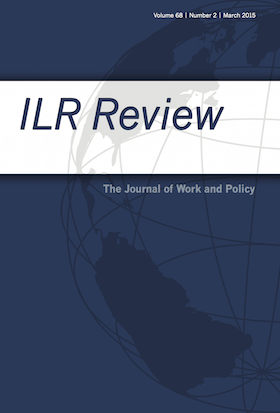
Measuring Job Creation, Growth, and Survival among the Universe of Start-ups in the United States Using a Combined Start-up Panel Data Set
in: ILR Review, No. 5, 2019
Abstract
The field of entrepreneurship is growing rapidly and expanding into new areas. This article presents a new compilation of administrative panel data on the universe of business start-ups in the United States, which will be useful for future research in entrepreneurship. To create the US start-up panel data set, the authors link the universe of non-employer firms to the universe of employer firms in the Longitudinal Business Database (LBD). Start-up cohorts of more than five million new businesses per year, which create roughly three million jobs, can be tracked over time. To illustrate the potential of the new start-up panel data set for future research, the authors provide descriptive statistics for a few examples of research topics using a representative start-up cohort.
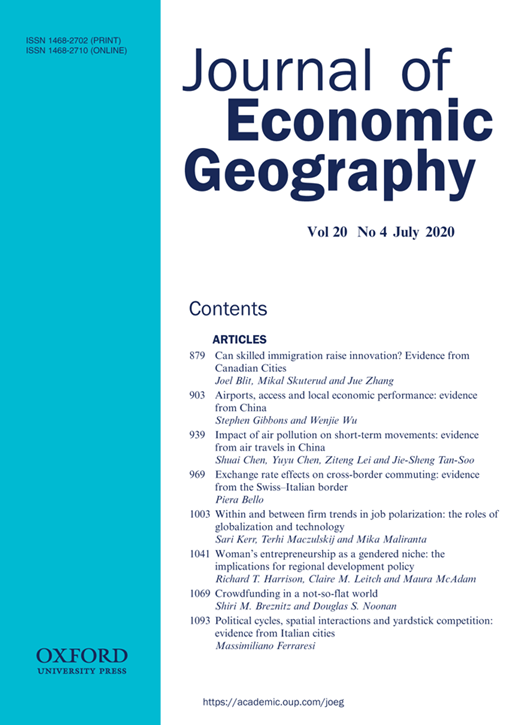
Taken by Storm: Business Financing and Survival in the Aftermath of Hurricane Katrina
in: Journal of Economic Geography, No. 6, 2018
Abstract
We use Hurricane Katrina’s damage to the Mississippi coast in 2005 as a natural experiment to study business survival in the aftermath of a capital-destruction shock. We find very low survival rates for businesses that incurred physical damage, particularly for small firms and less-productive establishments. Conditional on survival, larger and more-productive businesses that rebuilt their operations hired more workers than their smaller and less-productive counterparts. Auxiliary evidence from the Survey of Business Owners suggests that the differential size effect is tied to the presence of financial constraints, pointing to a socially inefficient level of exits and to distortions of allocative efficiency in response to this negative shock. Over time, the size advantage disappeared and market mechanisms seem to prevail.

Business Dynamics of Innovating Firms: Linking U.S. Patents with Administrative Data on Workers and Firms
in: Journal of Economics and Management Strategy, No. 3, 2018
Abstract
This paper discusses the construction of a new longitudinal database tracking inventors and patent-owning firms over time. We match granted patents between 2000 and 2011 to administrative databases of firms and workers housed at the U.S. Census Bureau. We use inventor information in addition to the patent assignee firm name to improve on previous efforts linking patents to firms. The triangulated database allows us to maximize match rates and provide validation for a large fraction of matches. In this paper, we describe the construction of the database and explore basic features of the data. We find patenting firms, particularly young patenting firms, disproportionally contribute jobs to the U.S. economy. We find that patenting is a relatively rare event among small firms but that most patenting firms are nevertheless small, and that patenting is not as rare an event for the youngest firms compared to the oldest firms. Although manufacturing firms are more likely to patent than firms in other sectors, we find that most patenting firms are in the services and wholesale sectors. These new data are a product of collaboration within the U.S. Department of Commerce, between the U.S. Census Bureau and the U.S. Patent and Trademark Office.
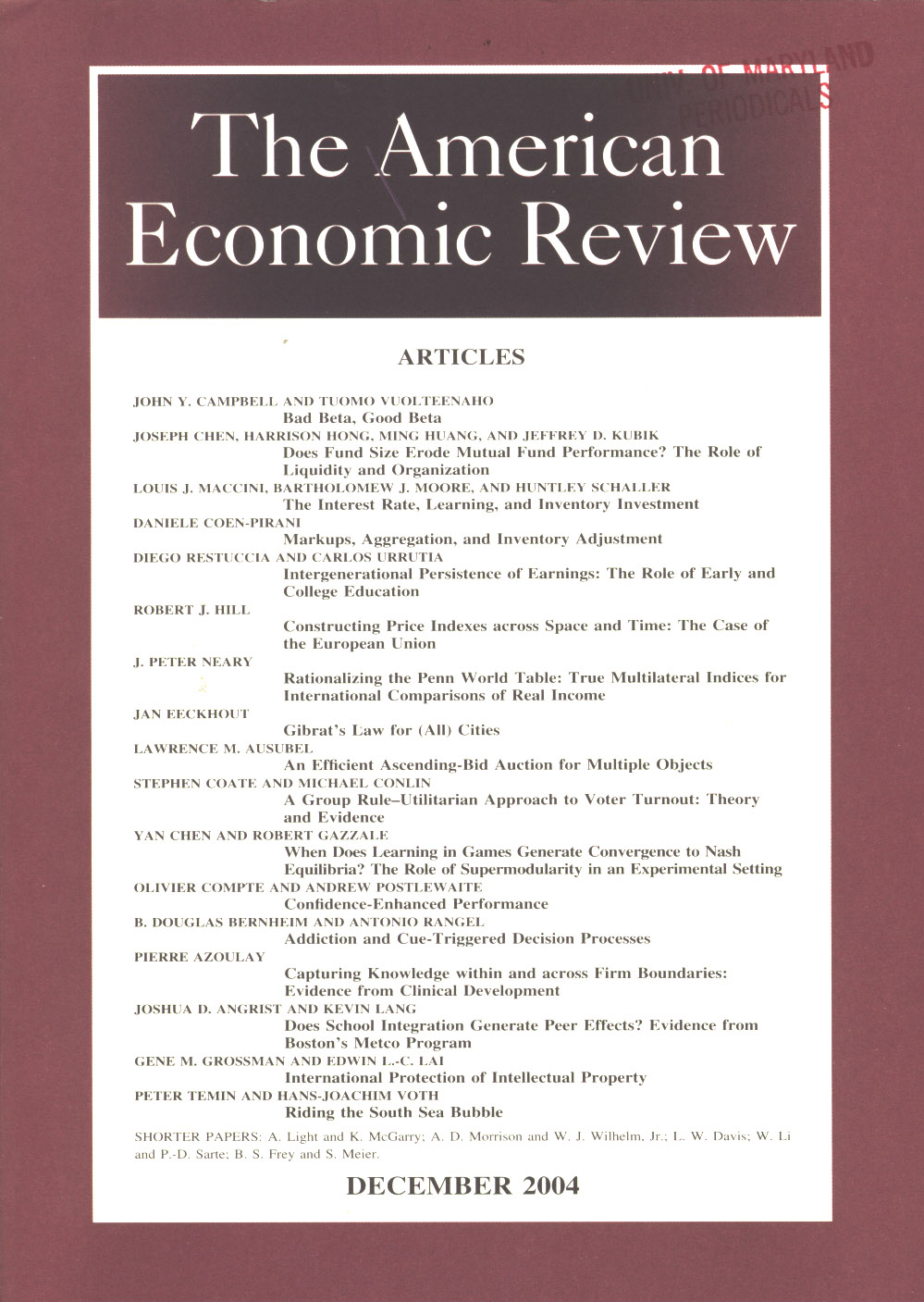
Declining Dynamism, Allocative Efficiency, and the Productivity Slowdown
in: American Economic Review: Papers and Proceedings, No. 5, 2017
Abstract
A large literature documents declining measures of business dynamism including high-growth young firm activity and job reallocation. A distinct literature describes a slowdown in the pace of aggregate labor productivity growth. We relate these patterns by studying changes in productivity growth from the late 1990s to the mid 2000s using firm-level data. We find that diminished allocative efficiency gains can account for the productivity slowdown in a manner that interacts with the within-firm productivity growth distribution. The evidence suggests that the decline in dynamism is reason for concern and sheds light on debates about the causes of slowing productivity growth.

Taking the Leap: The Determinants of Entrepreneurs Hiring Their First Employee
in: Journal of Economics and Management Strategy, No. 1, 2017
Abstract
Job creation is one of the most important aspects of entrepreneurship, but we know relatively little about the hiring patterns and decisions of start‐ups. Longitudinal data from the Integrated Longitudinal Business Database (iLBD), Kauffman Firm Survey (KFS), and the Growing America through Entrepreneurship (GATE) experiment are used to provide some of the first evidence in the literature on the determinants of taking the leap from a nonemployer to employer firm among start‐ups. Several interesting patterns emerge regarding the dynamics of nonemployer start‐ups hiring their first employee. Hiring rates among the universe of nonemployer start‐ups are very low, but increase when the population of nonemployers is focused on more growth‐oriented businesses such as incorporated and employer identification number businesses. If nonemployer start‐ups hire, the bulk of hiring occurs in the first few years of existence. After this point in time, relatively few nonemployer start‐ups hire an employee. Focusing on more growth‐ and employment‐oriented start‐ups in the KFS, we find that Asian‐owned and Hispanic‐owned start‐ups have higher rates of hiring their first employee than white‐owned start‐ups. Female‐owned start‐ups are roughly 10 percentage points less likely to hire their first employee by the first, second, and seventh years after start‐up. The education level of the owner, however, is not found to be associated with the probability of hiring an employee. Among business characteristics, we find evidence that business assets and intellectual property are associated with hiring the first employee. Using data from the largest random experiment providing entrepreneurship training in the United States ever conducted, we do not find evidence that entrepreneurship training increases the likelihood that nonemployers hire their first employee.
Working Papers
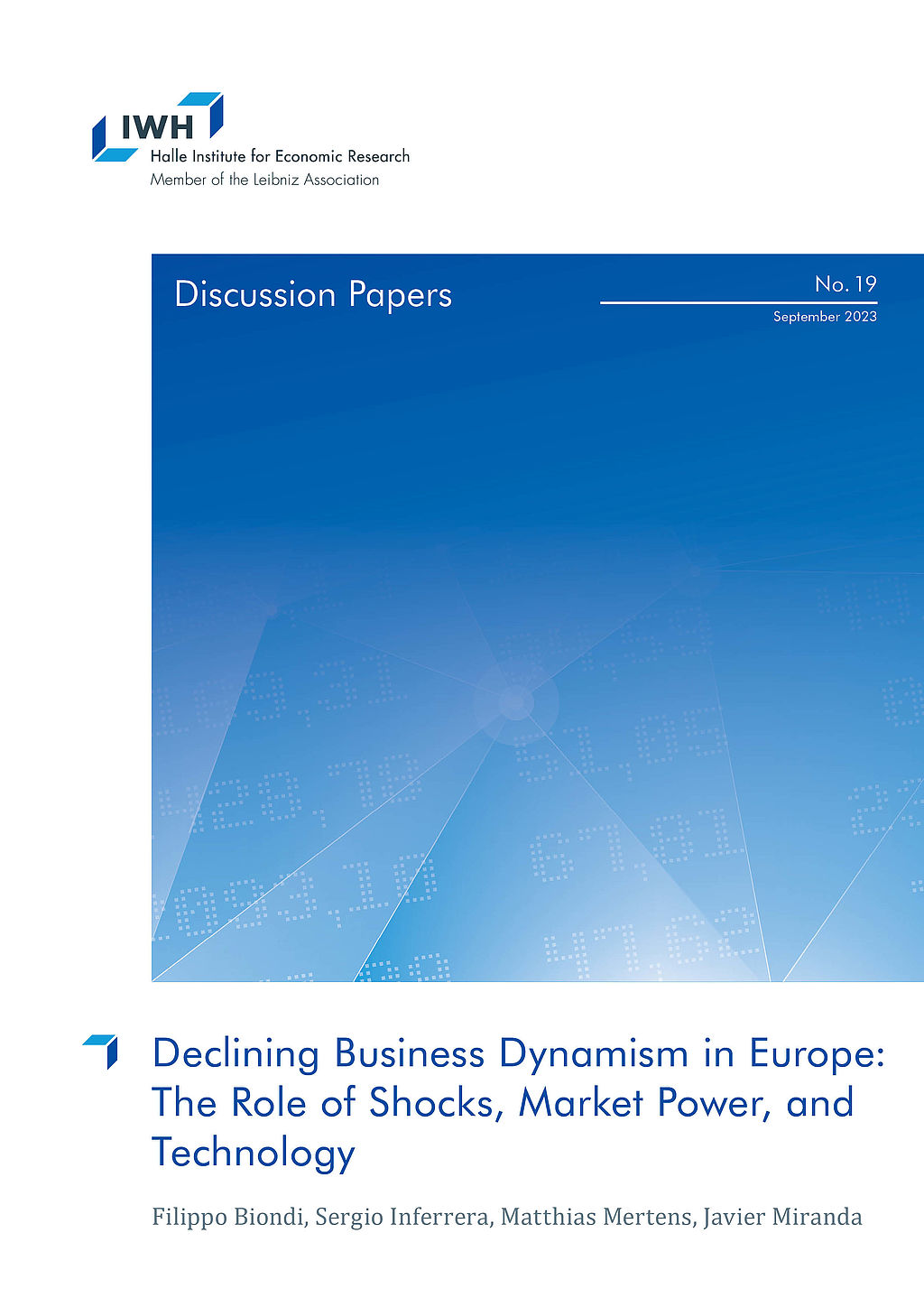
Declining Business Dynamism in Europe: The Role of Shocks, Market Power, and Technology
in: IWH Discussion Papers, No. 19, 2023
Abstract
We study changes in business dynamism in Europe after 2000 using novel micro-aggregated data that we collected for 19 European countries. In all countries, we document a broad-based decline in job reallocation rates that concerns most economic sectors and size classes. This decline is mainly driven by dynamics within sectors, size, and age classes rather than by compositional changes. Large and mature firms experience the strongest decline in job reallocation rates. Simultaneously, the employment shares of young firms decline. Consistent with US evidence, firms’ employment has become less responsive to productivity shocks. However, the dispersion of firms’ productivity shocks has decreased too. To enhance our understanding of these patterns, we derive and apply a novel firm-level framework that relates changes in firms’ sales, market power, wages, and production technology to firms’ responsiveness and job reallocation.
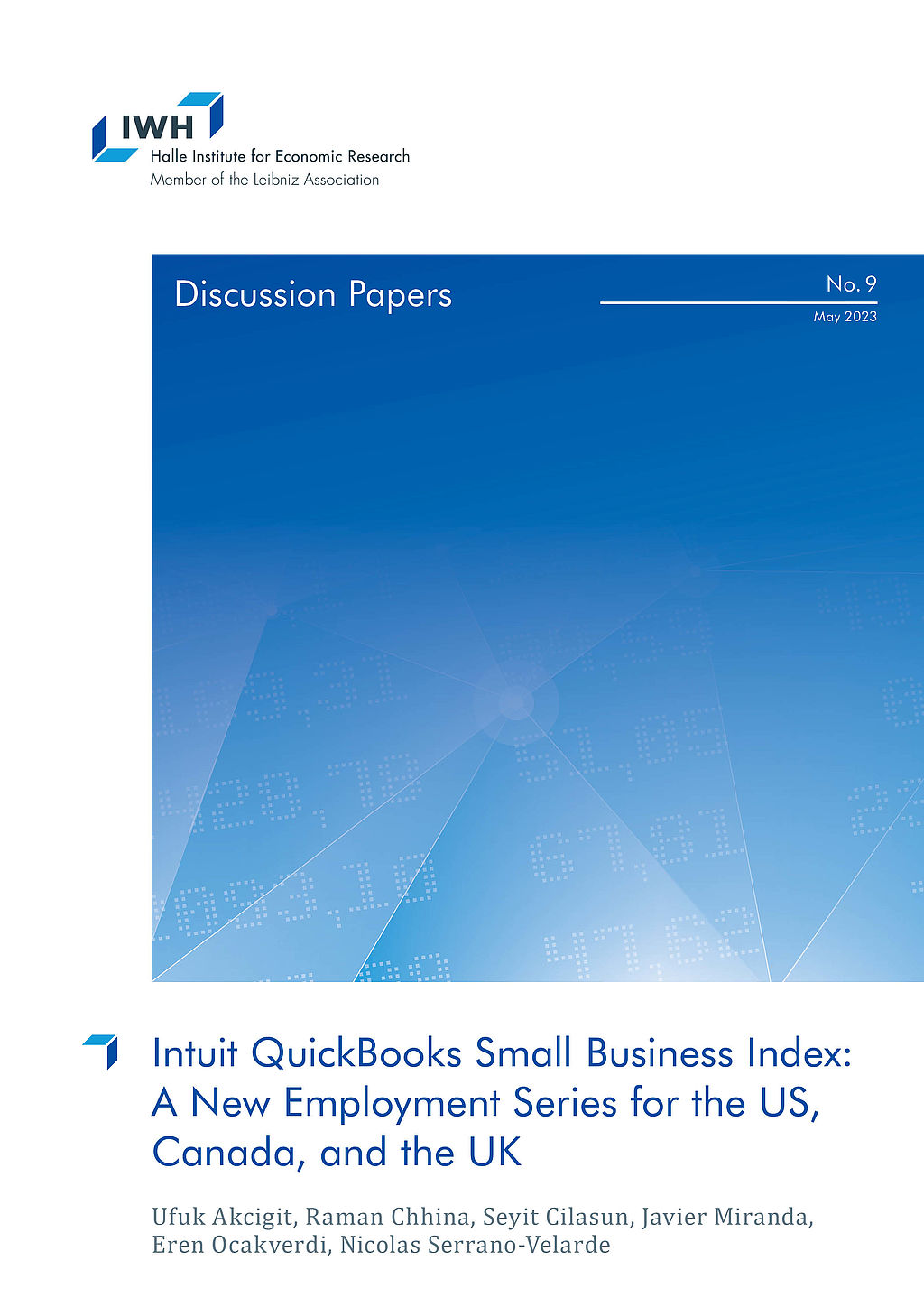
Intuit QuickBooks Small Business Index: A New Employment Series for the US, Canada, and the UK
in: IWH Discussion Papers, No. 9, 2023
Abstract
Small and young businesses are essential for job creation, innovation, and economic growth. Even most of the superstar firms start their business life small and then grow over time. Small firms have less internal resources, which makes them more fragile and sensitive to macroeconomic conditions. This suggests the need for frequent and real-time monitoring of the small business sector’s health. Previously this was difficult due to a lack of appropriate data. This paper fills this important gap by developing a new Intuit QuickBooks Small Business Index that focuses on the smallest of small businesses with at most 9 workers in the US and the UK and at most 19 workers in Canada. The Index aggregates a sample of anonymous Quick- Books Online Payroll subscriber data (QBO Payroll sample) from 333,000 businesses in the US, 66,000 in Canada, and 25,000 in the UK. After comparing the QBO Payroll sample data to the official statistics, we remove the seasonal components and use a Flexible Least Squares method to calibrate the QBO Payroll sample data against official statistics. Finally, we use the estimated model and the QBO Payroll sample data to generate a near real-time index of economic activity. We show that the estimated model performs well both in-sample and out-of-sample. Additionally, we use this analysis for different regions and industries. Keywords:
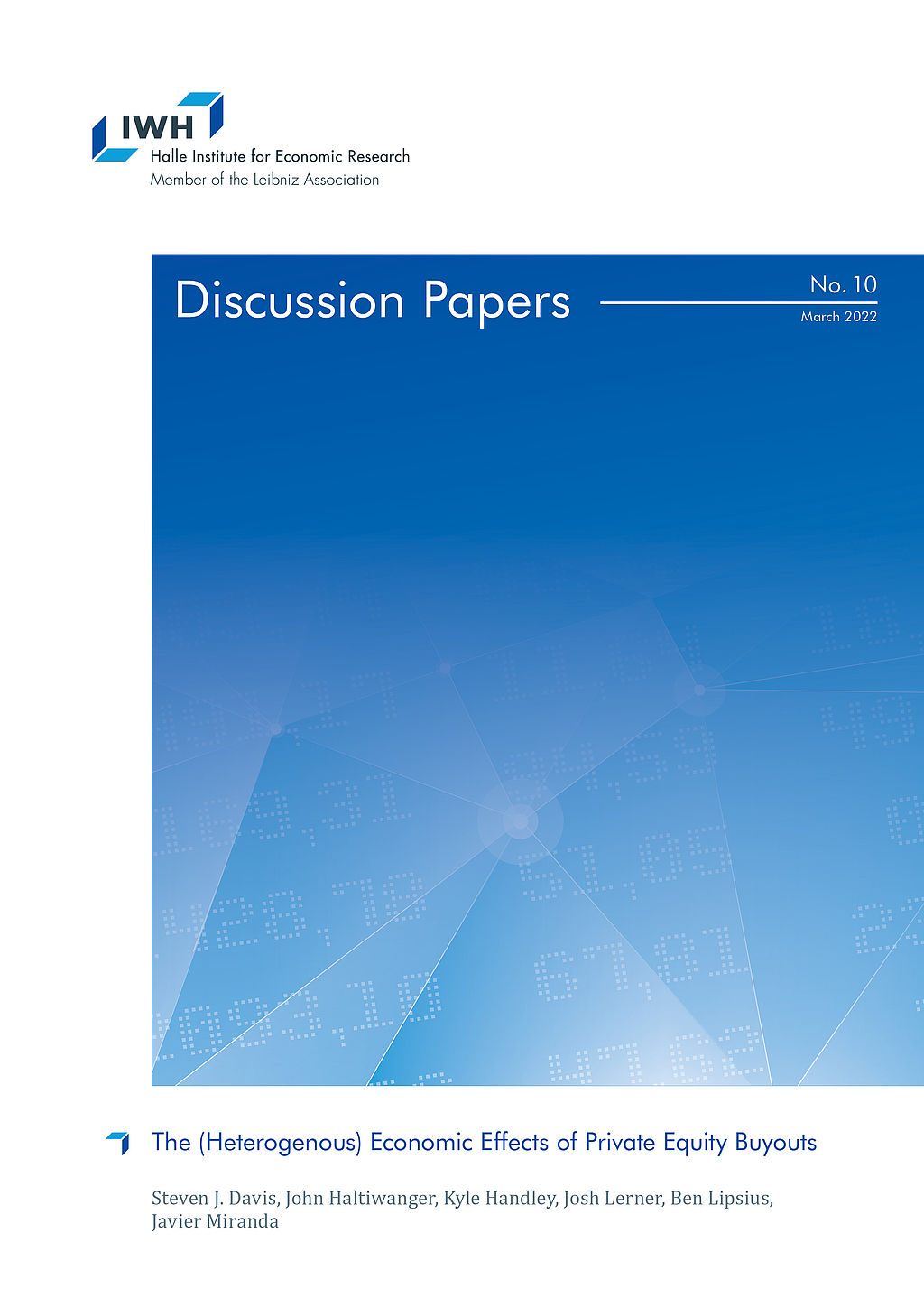
The (Heterogenous) Economic Effects of Private Equity Buyouts
in: IWH Discussion Papers, No. 10, 2022
Abstract
The effects of private equity buyouts on employment, productivity, and job reallocation vary tremendously with macroeconomic and credit conditions, across private equity groups, and by type of buyout. We reach this conclusion by examining the most extensive database of U.S. buyouts ever compiled, encompassing thousands of buyout targets from 1980 to 2013 and millions of control firms. Employment shrinks 13% over two years after buyouts of publicly listed firms – on average, and relative to control firms – but expands 13% after buyouts of privately held firms. Post-buyout productivity gains at target firms are large on average and much larger yet for deals executed amidst tight credit conditions. A post-buyout tightening of credit conditions or slowing of GDP growth curtails employment growth and intra-firm job reallocation at target firms. We also show that buyout effects differ across the private equity groups that sponsor buyouts, and these differences persist over time at the group level. Rapid upscaling in deal flow at the group level brings lower employment growth at target firms.

Measuring the Impact of Household Innovation using Administrative Data
in: NBER Working Paper, No. 25259, 2018
Abstract
We link USPTO patent data to U.S. Census Bureau administrative records on individuals and firms. The combined dataset provides us with a directory of patenting household inventors as well as a time-series directory of self-employed businesses tied to household innovations. We describe the characteristics of household inventors by race, age, gender and U.S. origin, as well as the types of patented innovations pursued by these inventors. Business data allows us to highlight how patents shape the early life-cycle dynamics of nonemployer businesses. We find household innovators are disproportionately U.S. born, white and their age distribution has thicker tails relative to business innovators. Data shows there is a deficit of female and black inventors. Household inventors tend to work in consumer product areas compared to traditional business patents. While patented household innovations do not have the same impact of business innovations their uniqueness and impact remains surprisingly high. Back of the envelope calculations suggest patented household innovations granted between 2000 and 2011 might generate $5.0B in revenue (2000 dollars).

Development of Survey Questions on Robotics Expenditures and Use in U.S. Manufacturing Establishments
in: Center for Economic Studies (CES) Working Paper Series, No. 44, 2018
Abstract
The U.S. Census Bureau in partnership with a team of external researchers developed a series of questions on the use of robotics in U.S. manufacturing establishments. The questions include: (1) capital expenditures for new and used industrial robotic equipment in 2018, (2) number of industrial robots in operation in 2018, and (3) number of industrial robots purchased in 2018. These questions are to be included in the 2018 Annual Survey of Manufactures. This paper documents the background and cognitive testing process used for the development of these questions.













